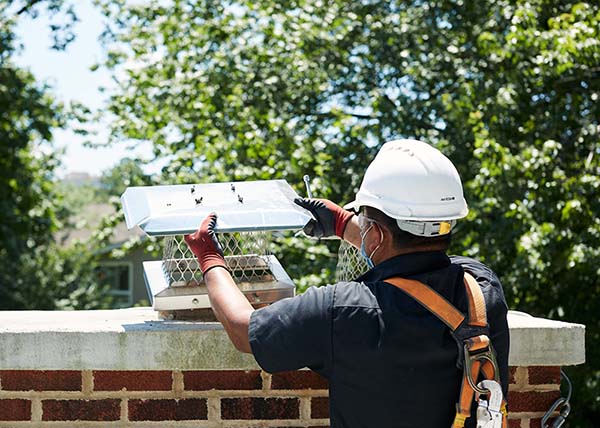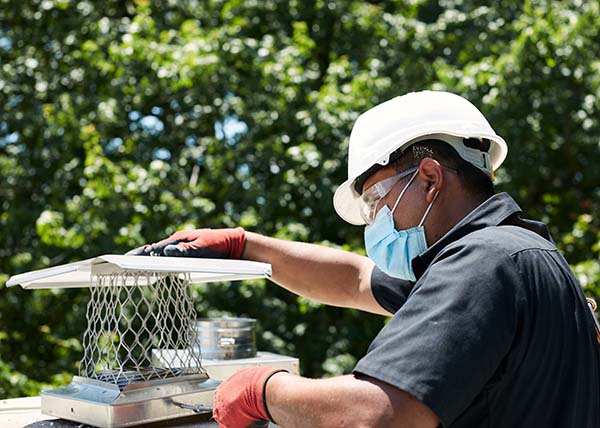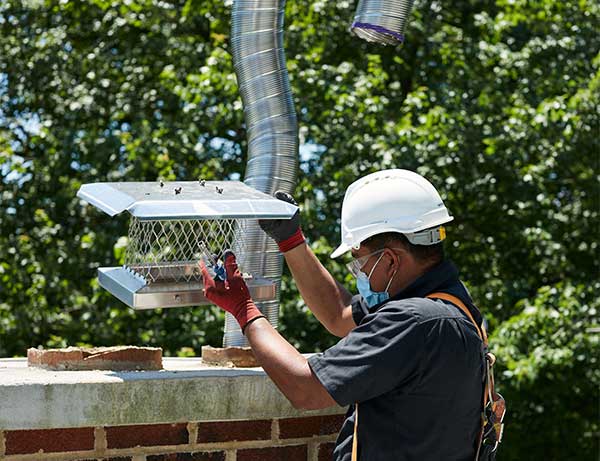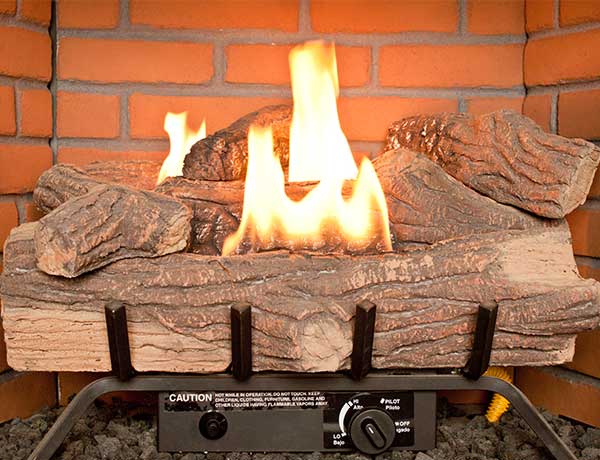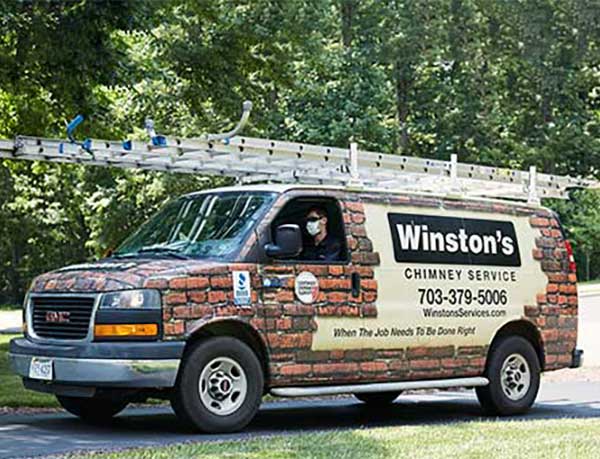We Install Dampers and Chimney Caps – The Ultimate Duo for Efficiency
If you own a chimney, there are a couple parts of it you might overlook – like chimney caps and dampers – which are a lot more important than most give them credit for. Most fireplaces will come with a simple lever throat damper, but most do not come with a chimney cap. That said, both are vital in keeping your chimney and fireplace running efficiently and safely season after season.
If you need a new component installed or any chimney parts repaired, trust our experts. We serve Northern VA with care and dedication.
What Is a Chimney Cap?
Chimney caps protect the flue from rain, leaves, birds, raccoons, and squirrels. Why is this important?
- The rain can end up in your fireplace and on your outer hearth.
- Water breaks down masonry, triggers rust, and makes your system unsafe for use.
- Birds can be noisy and, as in the case of chimney swifts, might be federally protected migratory birds that cannot be removed. You have to wait until they migrate away, then sweep the chimney and cap it.
- Raccoons and squirrels can bring fleas into the home as well as urinate and defecate on the smoke shelf. Raccoons will usually stay in the chimney and just climb in and out.
- If the damper is left open, squirrels have been known to venture into the home and wreak havoc trying to get back outside.
In the end, spending a little money up front for a simple chimney cap is a great investment – and can save you a lot of stress down the line. Make sure the cap incorporates a screen to ensure animals can’t get access to the flue, and make sure whoever inspects your system each year checks on the condition of the flue cap as well.
What Is a Chimney Damper?
Most fireplaces have throat dampers that sit at the top of the firebox and close the flue off when the unit is not in use. You simply open the damper when you want to have a fire, so the smoke and chemicals can be exhausted up and out the flue when a fire is lit.
Most people are fine with these types of dampers. …until they break or get off the track they sit on. Once that happens, it might be time to think about a top-end damper.
What’s a top-end damper?
A top-end damper is one that actually sits at the top of the flue like a chimney cap and is closed by a handle at the side of the firebox when not in use. The main difference between this and a throat damper is energy savings. These have a tighter seal and, because they sit at the top, the core of the chimney won’t cool down in the winter or heat up in the summer – which then keeps your home more regulated.
In fact, studies have shown that these types of dampers can save up to 10% of your heat loss in the winter months. This is the main reason people are changing over from the old style throat dampers to the top-end dampers.
What Are the Types of Chimney Caps Available?
There are several different types of chimney caps available to suit nearly any type of chimney. Whether you have a free-standing masonry-style chimney, a factory-built prefabricated fireplace, a gas vent system, or a decorative fire feature, there is sure to be an equally beneficial and stylish chimney cap specifically designed for it.
Single-Flue Chimney Cap
A single-flue chimney cap sits on top of the flue to protect the interior system and prevent water, leaves, and other debris from entering the venting system. These units are easy to install, and they come in a variety of styles. Your sweep will attach yours to the top of the flue, securing it with clips or hardware around the base. This keeps it in place even during inclement weather and strong winds.
Single-flue chimney caps also assist in preventing downdrafts, and they help contain sparks from exiting your fireplace and landing on any flammable roofing materials. If they are equipped with a screen they can also help prevent animals from entering the system. All in all, a single-flue chimney cap is a smart and affordable investment that can help you avoid lots of issues down the line.
Multi-Flue Chimney Cap
Like single-flue options, a multi-flue chimney cap is also used to protect the chimney and home from outdoor elements, such as precipitation, downdrafts, and animals. These are typically made of metal, often stainless steel or copper, and feature ventilated sides. The big difference with these is that they can accommodate a chimney with multiple flues, providing that extra protection the system needs.
Multi-flue chimney caps…
- act as a shield to keep rain and snow from blowing down into the interior of the home
- keep sparks and burning embers from drifting onto the roof
- if screened, keep pests and other animals from nesting inside the chimney
- prevent wind gusts from forcing air down into the home
And if you’re concerned about aesthetics, don’t stress. Well-designed multi-flue caps can accentuate existing architecture, while offering both efficiency benefits and peace of mind.
Top-Mount Chimney Cap
A top-mount chimney cap is a metal cover that fits on the top of the chimney. It prevents animals, debris, and weather from entering through any gaps in the chimney flue without obstructing proper ventilation.
This kind of chimney cap is typically made out of galvanized steel or stainless steel for superior durability against harsh outdoor conditions. It should also come with mesh sides, so proper airflow can be adhered to and creosote deposits are kept at a minimum. Top-mount chimney caps are easy to install and can provide several years of hassle-free protection from unwanted intrusions.
Full-Coverage Chimney Cap
Like the cap options listed above, a full-coverage chimney cap will safeguard your chimney from water, outside debris, and animals, while also helping to prevent errant sparks or hot embers from accidentally escaping onto the surrounding roofing materials or debris buildup on the roof.
Made of stainless steel or copper, full-coverage caps feature wire mesh walls with a slanted top that allows rainwater to drain off and away from the chimney. They are designed in a number of shapes and sizes, which helps to accommodate any variety of chimney openings.
And professional installation with this type of cap is relatively quick and easy. Long story short, investing in a full-coverage chimney cap is a no-brainer – and one of the smartest choices for those who want to keep their home guarded from water damage all year long.
Ready to invest in your new cap?
From standard metal versions that protect from sparks and creosote buildup to decorative copper “giants,” there are many chimney cap options for the savvy homeowner. And while many of the options listed above seem similar, each type serves its own purpose and adds its own unique aesthetic touch.
Whether you’re going for a more industrial look for open fireplaces or something more elegant, we can help you out. And with proper care and maintenance, rest assured you can get years of use and protection.
What Is the Best Type of Chimney Cap?
So, you get it – if you own a chimney, having a chimney cap installed at the top of it is essential for keeping your chimney and your home better protected for the long haul. That said, as indicated above, it’s clear that there are a number of caps to choose from. So… which is best?
Here at Winston’s, we believe that a full-coverage cap is the way to go. Why?
- It offers the best protection from water intrusion.
- It guards against animal and bird intrusion.
- It acts as a spark arrestor, keeping embers and sparks from reaching your roof.
That said, it’s important to research the different options available before making any final selections, so that you find one that works best for your home and budget. We’d be happy to help.
What Are the Types of Chimney Dampers Available?
There are two main types of chimney dampers. The most common type is the throat damper, which seals off just above the firebox. Top-mounted dampers are another option, and these provide an adjustable seal from outside the chimney, preventing cold air and downdrafts from entering right from the top.
What is the best types of damper available?
The best type of chimney damper for your fireplace depends a lot on the size and age of your chimney. If you have an older and smaller chimney, a top-sealing damper would be ideal as it seals tightly shut when your system isn’t in use.
Newer and larger units, though, are normally equipped with throat dampers, as they hang just above the firebox and will more effectively prevent backdrafts. Some models are also outfitted with a lever so that you can easily open or close it while sitting by the fire.
No matter which type of damper you choose, make sure that it is installed correctly and regularly inspected so that your family can enjoy efficient warm fires for many years to come. We’re here to help with it all.
How Do Dampers & Chimney Caps Improve Efficiency?
Installing dampers and chimney caps on a home’s chimney is an effective step towards improving a home’s overall efficiency levels. Dampers are meant to be placed at the base of the fireplace, acting as a gate that can be opened and closed depending on the homeowner’s needs. By keeping cold air from entering through the chimney when closed, they can help to better regulate indoor temperatures.
Chimney caps come in multiple sizes and keep debris, animals, and other elements from entering your home through the chimney opening. When installed properly, these elements will also stop outside air from being drawn into the home unnecessarily.
In the end, installing dampers and chimney caps can help homeowners to improve their home’s energy usage for both heating and cooling – leading to better comfortability and lower bills, with less stress on your HVAC system.
When Should I Replace My Damper or Chimney Cap?
Chimney caps and dampers both serve important purposes, but they’re not indestructible. Every so often you’ll need to replace these components, so knowing when they’re on their last leg is important for keeping your household safer.
Dampers should be inspected regularly for wear and tear, specifically for rusted-out areas or damage in the seals. The same applies to checking the condition of your chimney cap. If you see worn, corroded, or missing parts, then it’s time to consider a replacement. Doing so will help prevent problems like water leaking into the flue or animals entering the system.
A new damper can also improve air tightness for lower energy bills and improved fireplace performance. In the end, regular inspections are well worth it when you consider what can occur if these components aren’t working right.
What Size Damper or Chimney Cap Do I Need for My Chimney?
Sizing the right damper or chimney cap for your chimney is an important part of ensuring safer and more efficient operation. If we told you how many times sizing has been an issue throughout the years, you would be shocked. In fact, we’ve been called in for a second opinion countless times due to faulty installs. It’s not as easy as many think to get it right.
For that reason, we ask that you call us in to do the measuring right from the start. This also protects you from having to pay for something more than one time. If you measure and it’s wrong, you have to pay for a new component all over again. But if we measure and it’s wrong, we’re the responsible party – and rest assured, we will correct it.
Call Today for the Quality Protection Your Chimney Deserves
For a new chimney cap or damper, or if you need repairs or an inspection or sweeping completed, call on the team here at Winston’s Chimney Service. Dial 703-379-5006 or fill out an appointment form online now to get started.
If you notice a smelly chimney in your home, call Winston’s Chimney Service to get the best masonry repair services available, starting with troubleshooting the problem.

